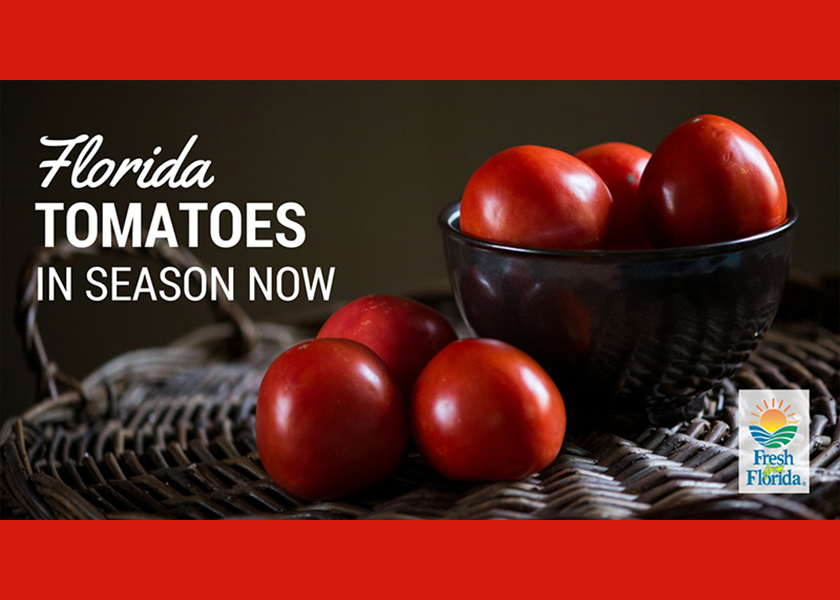Weathering the storm, the next tomatoes plump up

Rolling in much later than is typical in the Atlantic hurricane season, Tropical Storm Eta hit Florida twice: first on Nov. 8 in South Florida and then on Nov. 12 along the Gulf Coast, dumping as much as 8 inches of rain on tomato crops in a 24-hour period.
“The early fall season has been wetter than usual, climaxing with Tropical Storm Eta that impacted growing regions in both south and central Florida during the second week of November,” said Michael Schadler, executive vice president of the Florida Tomato Exchange, Maitland.
He’s also in charge of the Florida Tomato Committee and the Florida Tomato Growers Exchange, all distinct trade associations.
“It is very rare to have a tropical storm come through Florida so late in the year, but thankfully we were spared any significant damage, even if there were some modest crop losses and resulting quality issues,” Schadler said.
October and early November volumes were lighter than usual because of that storm, but since then, volume has been picking up with dry, mild weather, he said.
Planted acreage and the mix of varieties should be about the same as 2019. Round slicer or beefsteak tomatoes represent nearly 70% of the crop, with plum/romas, grape and cherry tomatoes comprising most of the rest.
The state has about 50 commercial tomato growers, all together creating a nine-month season. Those in North Florida start harvesting in early October, and the harvest works its way down the peninsula throughout the fall and winter.
The harvest then heads back up the peninsula to central Florida in the spring and to north Florida in the early summer, usually ending by Independence Day.
Bob Spencer, vice president of sales at West Coast Tomato, Palmetto, Fla., said his company started harvesting at the end of October after a warmer than usual growing season.
The company has a packing house in Palmetto, with farms in Manatee County in central Florida and Immokalee in southwest Florida.
“Normally, our weather pattern dips into the 60s by the 15th or 20th of October, but the very warm weather continued into November, and that means your fruit tends to be smaller,” Spencer said.
By mid-November, the temperatures dropped a bit, allowing the tomatoes to size up more.
Fall yields will be down a bit, but “there’s a good, strong market,” Spencer said.
Still, drastic market fluctuations are a characteristic of 2020.
By Nov. 18, Spencer said he’s been dealing with renewed uncertainty as some governors in the Midwest and Northeast have started shutting down again with more coronavirus outbreaks and resurgences.
“That’s created uncertainty in some of our customers on how much they’ll be able to sell, as people are not allowed to dine indoors,” Spencer said.
With a vaccine in sight, he is optimistic that pandemic-related business restrictions will ease in the near future.
Outside, Tropical Storm Eta affected mostly just the early fall tomatoes, causing them to size small for a higher percentage of combo and U.S. No. 2 grade, Schadler said.
“There was more rain down south in the Immokalee area, and fortunately we weren’t harvesting when it came through,” Spencer said.
Those southwest Florida tomatoes were still growing and young enough to have harder skin when the storm first hit the state.
“But as we get away from the impact of those early season weather events, we’re looking forward to the normal high standard for Florida tomato quality,” Schadler said.
The crop has been highly variable the past couple of years.
The value of Florida’s tomato production was $425.9 million in 2019 compared to $344.1 million in 2018, according to the U.S. Department of Agriculture’s National Agriculture Statistics Service.
That’s an $81.8 million jump while at the same time, farmers planted 2,000 fewer acres of tomatoes, from 29,000 acres in 2018 to 27,000 acres in 2019.
However, Category 5 Hurricane Michael slammed into the Florida Panhandle in October 2018, destroying tomatoes about to be harvested.
Farmers yielded 280,000 pounds of tomatoes per acre in 2018, compared to 300,000 pounds per acre in 2019.
As far as this 2020 calendar year’s winter, spring and early fall harvesting seasons, the state shipped 35 million pounds of tomatoes through Nov. 18, compared to 68.7 million pounds in the same window in 2019 — almost half as much as the prior year.
A lot of 2020’s late winter and early spring crops were affected by the pandemic-related shutdowns, Schadler said.
“Many growers had to leave tomatoes unharvested or donate tomatoes that lost a market when restaurants began shutting down,” he said.
“With markets now more accustomed to dealing with COVID’s uncertainties, we hope to be able to slightly increase the volume of tomatoes shipped compared to last season.”
Meanwhile, Mexican tomato shipments that crossed through Laredo, Texas, reached almost 150 million pounds in 2020 through Nov. 18. Those Laredo numbers weren’t listed for 2019.
The exchange is keeping an eye on Mexican tomato imports through TomatoMonitor.com to ensure adherence to the Suspension Agreement.







